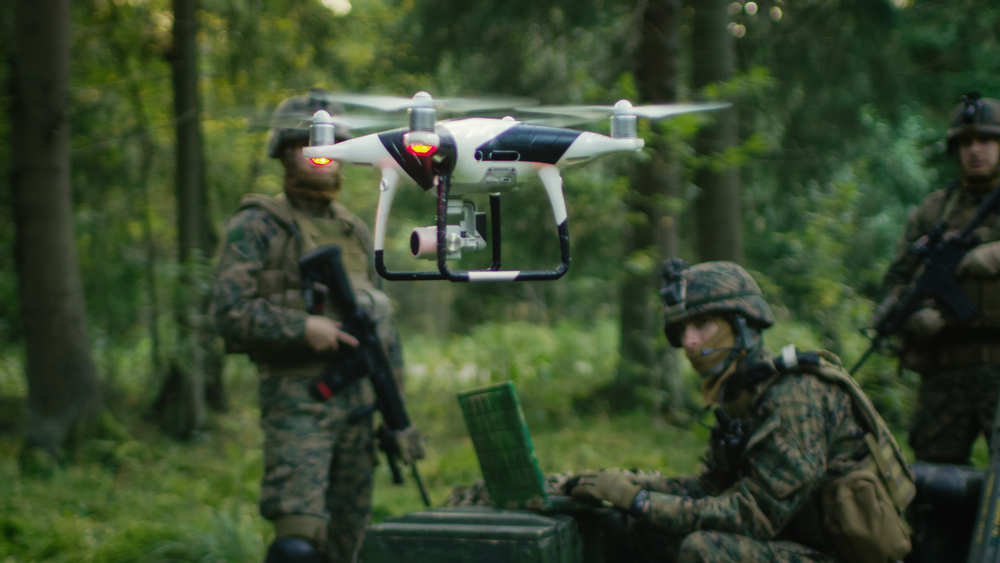New Weapons for New Wars

The rules of warfare have not changed, but its battlefields have evolved dramatically with the rise of AI, drones, and other technological advancements.
In our digital age, wars are won not just on land, sea, and air with bombs, but also in space and cyberspace through electronic and information weapons. Today’s artillery extends far beyond the usual machinery and is becoming ever more sophisticated at a breathtaking rate.
Innovations in science and technology have found applications for national security and defense, and countries that are at an advantage are now making use of this cutting-edge knowledge to ensure global dominance.
With the current conflict between Ukraine and Russia in the spotlight, how governments engage in war has placed some emphasis on these new advancements in tech. Here are a few that stand out.

Drones: modern fighters in the sky
The use and deployment of drones or UAVs (unmanned aerial vehicles) in warfare is not new. Its usefulness and effectiveness have been proven time and again in various conflicts around the world so military experts continually find new ways to improve these.
Drones are relatively low-cost and “attritable”. For the military, this means that drones are not expected to have a long-life expectancy, and are in a sense, expendable, which is why these are ideal when it comes to penetrating territories that are highly defended.
Another advantage of using drones is their ability to carry out missions and tasks with limited human intervention. These lessen risk and casualties to human soldiers, especially in tight, densely defended areas.
Drones are reliable even when GPS or satellite navigation do not work, and these can perform tasks related to intelligence gathering, surveillance, reconnaissance, and even target attacks.
Among the UAV innovations, the U.S. military developed are 3d printed combat-capable drones. These have assisted fighter pilots in avoiding the risks of loitering over enemy territory. According to the SCO (Strategic Capabilities Office), these micro-drones show “swarm behaviors” and act as one unit when these are deployed. The drones collectively make decisions, fly in adaptive formation, and even self-heal.
Today, the use of drones in warfare has once again become a relevant topic as Ukraine has been defending its own with the help of TB2 Baykratar drones from Turkey. Measuring 39 feet long, these drones have a wingspan of 21 feet and have an operational altitude of 18,000 feet. It has speeds of 138 mph and can carry about 330 pounds of smart munitions.
AI: a new ally…and enemy
Apart from drones and other combat vessels being assisted with artificial intelligence, AI’s role in warfare goes beyond directing missiles and making machines more efficient for human operators.
Now more than ever, information is being used to spread massive disinformation to the public. Unfortunately, AI plays a role in the spread of lies, fake news, and misleading information. It is becoming increasingly difficult to discern a deep fake video from what is real. On the upside, it is also through AI technology that agencies can weed out what is false from the truth. Through machine learning, AI helps fight the battle against disinformation.
(Also read: IoT and Our New Normal)
AI has been instrumental in the current conflict of Ukrainians on-ground. Open-sourced information uploaded by ordinary citizens to various social media platforms about troop formations and attacks in their immediate area empowered civilians. With the help of AI, this information uploaded was quickly analyzed and provided receipts in the documentation of possible atrocities committed by the enemy.
The ultimate fear when it comes to AI and warfare is in the creation of killer robots—AI being used to program weapons that would wipe out the maximum number of targets efficiently and indiscriminately. In 2017, tech leaders and AI innovators like Elon Musk took a pledge never to contribute to the creation of “lethal autonomous weapons”.
The development surrounding the ban of creating such weapons has become the subject of much discussion in the United Nations. However, the U.N. has not been successful in its campaign to outright ban countries from developing these.
Multiple, Synchronized, and Automatic Operations
Apart from developing the use of drones and exploring AI, the U.S. military has been working on a super cannon that can strike targets from a thousand miles away. The target range of existing cannons is about 25 miles. Military scientists are targeting 2024 for a test-fire.
Long-range artillery, coupled with more sophisticated multi-domain operations systems seems to be a priority when it comes to advancing ideas on regaining dominance. Modernization projects such as the “Joint All-Domain Command and Control” (JADC2) of the U.S. Army Command is a project that “coordinates combat across multiple fronts”.
An article from Scientific American describes the system behaving similarly to ride app shares that combines location data, information on distance, and travel time to match a car with a passenger. According to the piece, “JADC2 aims to pool all U.S. military intelligence, surveillance and reconnaissance in a data cloud and to use artificial intelligence and algorithms to match the best weapon against a given target.”
Tech in wartime
While the world strives for peace, war forces innovations in science and technology to develop further and strive for better. Giant leaps have been made in almost all fields because of urgent calls for survival and defense. Most of us hope for better, lifegiving applications to many of these advancements instead of finding more efficient ways to kill. Perhaps one day we will. Maybe someday humanity will learn, as the AI named Joshua from the classic movie “Wargames” said, “the only winning move is not to play.”
As one of the Top 21 EMS companies in the world, IMI has over 40 years of experience in providing electronics manufacturing and technology solutions.
We are ready to support your business on a global scale.
Our proven technical expertise, worldwide reach, and vast experience in high-growth and emerging markets make us the ideal global manufacturing solutions partner.
Let's work together to build our future today.



